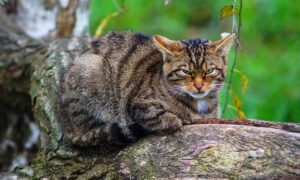Staff and keepers at Bristol Zoo (UK) have been left distressed after an entire family of rare warty pigs were eaten by the male of the family, and a rare lion headed golden tamarin (monkey) was eaten by hungry otters after it escaped and fell in to a pond.
A zoo lost some of its most endangered animals when a male warty pig ate his entire family and a rare monkey was eaten for lunch by hungry otters.
The incidents happened at Bristol Zoo in December and were shortly followed by further tragedy when three rainbow lorikeets escaped.
The zoo, which prides itself on its conservation measures, said the deaths had distressed keepers.
Source: The Telegraph
[divider]
 The Visayan warty pig (Sus cebifrons) is a critically endangered species of pig. The Visayan warty pig is endemic to two of the Visayan Islands in the central Philippines, and is threatened by habitat loss, food shortages, and hunting – these are the leading causes of the Visayan warty pig’s status as critically endangered. Due to the small numbers of remaining Visayan warty pigs in the wild, little is known of their behaviors or characteristics outside of captivity. (Wikipedia)
The Visayan warty pig (Sus cebifrons) is a critically endangered species of pig. The Visayan warty pig is endemic to two of the Visayan Islands in the central Philippines, and is threatened by habitat loss, food shortages, and hunting – these are the leading causes of the Visayan warty pig’s status as critically endangered. Due to the small numbers of remaining Visayan warty pigs in the wild, little is known of their behaviors or characteristics outside of captivity. (Wikipedia)
[divider]
 The golden-headed lion tamarin (Leontopithecus chrysomelas), also the golden-headed tamarin, is a lion tamarin endemic to Brazil. It is found only in the lowland and premontane tropical forest fragments in the state of Bahia, and therefore is considered to be an endangered species. It lives at heights of 3–10 metres (9.8–32.8 ft). Its preferred habitat is within mature forest, but with habitat destruction this is not always the case. Several sources seem to have different information on the number of individuals within a group, and the type of social system that may be apparent. The golden-headed lion tamarin lives within group sizes ranging from 2 to 11 individuals, with the average size ranging from 4 to 7. According to various sources, the group may consist of two adult males, one adult female, and any immature individuals, one male and one female and any immature individuals, or there may be one producing pair and a varying number of other group members, usually offspring from previous generations. There is not much known on its mating system, but according to different sources, and information on the possible social groups, it can be assumed that some may practice monogamous mating systems, and some may practice polyandrous mating systems. Both males and females invest energy in caring for the young, and all members of the group also help with juvenile care. (Wikipedia)
The golden-headed lion tamarin (Leontopithecus chrysomelas), also the golden-headed tamarin, is a lion tamarin endemic to Brazil. It is found only in the lowland and premontane tropical forest fragments in the state of Bahia, and therefore is considered to be an endangered species. It lives at heights of 3–10 metres (9.8–32.8 ft). Its preferred habitat is within mature forest, but with habitat destruction this is not always the case. Several sources seem to have different information on the number of individuals within a group, and the type of social system that may be apparent. The golden-headed lion tamarin lives within group sizes ranging from 2 to 11 individuals, with the average size ranging from 4 to 7. According to various sources, the group may consist of two adult males, one adult female, and any immature individuals, one male and one female and any immature individuals, or there may be one producing pair and a varying number of other group members, usually offspring from previous generations. There is not much known on its mating system, but according to different sources, and information on the possible social groups, it can be assumed that some may practice monogamous mating systems, and some may practice polyandrous mating systems. Both males and females invest energy in caring for the young, and all members of the group also help with juvenile care. (Wikipedia)
















